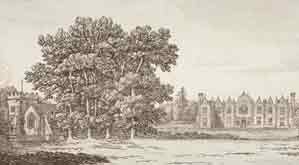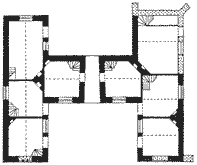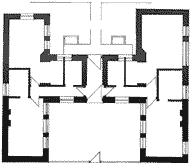
The six ancient charities concerned were;
- The Countess of Derby’s Almshouses
Charity.
- The Solomon Burbery Charity.
- The Mrs. Mary Ashby Charity (including
Baldwin’s gift) founded by Will dated 24 April 1664.
- The Poor’s or Fuel Allotment
Charity established by an Inclosure Award under the Enclosures Act in
1813.
- The Henry Goodman Charity founded
by Will proved on 20 May 1858.
- The Ashford and Moore Charity founded by Will proved on 10 April 1867.
The Countess of Derby’s Almshouses Charity
In about 1580 Lady Alice Spencer of Althorpe, and therefore in the lineage of the Duke of Marlborough, Winston Churchill and the late Princess of Wales, married Ferdinando Strange or Stanley, the fifth Earl of Derby. This marriage portrait celebrated the event.
 Lady Alice Countess of Derby. Click the image for an enlargement |
As the Dowager Countess of Derby, a title she retained for the rest of her life, she married her second husband, Sir Thomas Egerton, the Keeper of the Great Seal of England and lived as the Lady of the Manor in Harefield from 1599 until her death in 1637. In 1602 she and her husband entertained Queen Elizabeth I for three days at Harefield Place, adjacent to St. Mary’s Church in Harefield.
Sadly, Harefield Place no longer exists. Today, where it stood there is an Australian Military Cemetery in which the bodies of 114 Australians, 113 men and one woman lie, who died in the Australian Military Hospital in Harefield in the 1914 – 1918 World War. The world-famous Harefield Hospital now stands on the site of that hospital.
 Harefield Place Click the image for an enlargement |
In her Will Lady Alice established the Countess of Derby’s Almshouses Charity. This provided the "hospital" or almshouses, which still exist on Church Hill, Harefield, for "six poor women of good character of the Parish."
 |
 |
|||
| The wash drawing of 1794 shows the seperate entrances to the "appartments". | A current photograph of the Almshouses | |||
Click an image for an enlargement |
||||
The building is very attractive, of architectural importance and is statutorily listed Grade II*. However, it was fairly basic in its day but each woman had her own double storeyed "apartment", each with a separate front door and its own internal staircase. Two rooms were also provided for a curate or master, who was to say prayers for the women daily. A bake-house and a communal washhouse were also included.

 Plan as originally built. Plan after 1950s conversion Click an image for an enlargement |
This ground floor plan shows the Almshouses as constructed originally with the "apartments" each with its own front door and internal staircase.
The Trustees were required by the local council in the 1950s to upgrade the very poor sanitary provisions in the building so the accommodation was converted into four bed sitting rooms with their own kitchens but with shared bathrooms, all at ground level as indicated in the 1950s conversion plan.
The images of Harefield Place and the Almshouses in 1794 are reproduced with the kind permission of the Guildhall Library, Corporation of London.
Return to the top of page
The Solomon Burbery Charity
In 1697, the Will of Solomon Burbery of the City of London, left Littlewoods, now known as the Dairy Farm on Breakspear Road North on the edge of Harefield village, to provide income for his two sisters for their life times and then for the poor of Harefield forever. The Trustees of the Harefield Parochial Charities let the farm, which has an area of about 5.2 hectares or about 13.5 acres, on an agricultural tenancy and derive rent from it to provide for the objectives of the Charities – the relief of need in the Parish of Harefield.
Click here for a map showing the location of the Dairy Farm in the village.
Return to the top of page
The Mrs. Mary Ashby Charity (including Baldwin’s gift)
Mrs. Ashby, whose family owned the Breakspears estate in Harefield left a bequest of £100 in her Will in1664. This was to be invested and "the income expended on the poor". Earlier in 1622 Mrs. Ashby had also given £40 for the poor. In 1706 Mrs. Baldwin gave £20, "the interest of which was annually to be divided between six poor widows not receiving alms and who constantly attended church." Mrs. Baldwin was probably the widow of the Reverend John Baldwin, who was a curate at the Countess of Derby’s Almshouses.
Return to the top of page
The Poor’s or Fuel Allotment Charity.
The Poor's or Fuel Allotment Charity was established as a result of the Enclosures Act in 1813. The local Enclosure Commissioner for Harefield, John Trumper awarded "20 acres or thereabouts" of poor's land west of Tosses Lane (now the Northwood Road), Harefield, as freehold to "the Churchwardens and overseers in Trust for the poor for ever." This was in lieu of the rights of poor cottagers to cut furze and bushes on the common for fuel. This land was rented out and the rent received paid for fuel for such of the poor as did not receive parish relief. It would appear that this was the origin of the Coal Allocation payments made today by the Trustees to qualifying Harefield residents each Christmas.
In 1948, under threat from the Uxbridge Urban District Council to acquire the poor's land by compulsory purchase, it was sold with the agreement of the Charity Commission, for £8,000. The council housing around Newdigate Green and Newdigate Road East and John Penrose School were built on this land.
Commissioner Trumper also set apart another piece of common of 4 acres for use as a cricket ground and other recreations for the Parishioners of Harefield - the village green of today, which is often referred to as Harefield Common.
Return to the top of page
The Henry Goodman Charity
Henry Goodman left £500 in 1858 for flour, raisins and beer for 50 families.
Return to the top of page
The Ashford and Moore Charity.
John Ashford, who was a confidential servant to Sir Christopher Baynes of Harefield Place, left £600 for meat, bread, fuel and clothes for the aged poor, in 1857. Sadly, no reference to a Moore bequest has been found.
The endowment funds of the last four Charities were vested by the Charity Commission in the Official Trustees of Charitable Funds, and since 1992 in the Charities Official Investment Fund. The Trustees derive income from these endowments, which is used to meet their objectives.
Return to the top of page